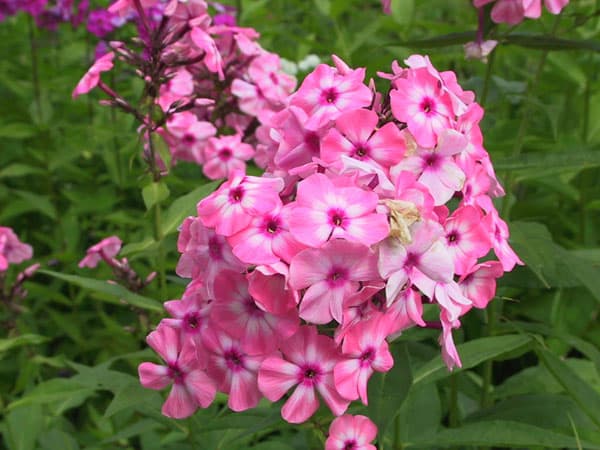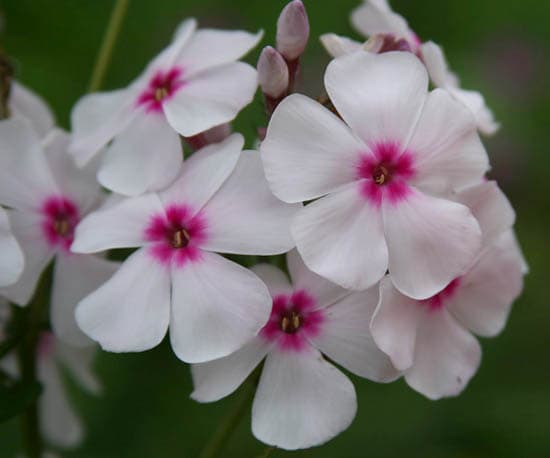Variety of colors!
Perennial, 70-90 cm.
After 3-4 years of planting, paniculate phlox bushes grow strongly and lose their decorative qualities. In the middle of the bush, the old phlox rhizome becomes woody, begins to stick out of the ground and dies, flowering and the appearance of the bush deteriorate (small flowers on small inflorescences, weak and short-term flowering, short stems, small leaves). When losing their decorative qualities, phlox bushes are dug up, divided and replanted.
Paniculate phlox can be planted in the fall - from mid-August and the first ten days of September, or in the spring - from the end of April and the first ten days of May. In the fall, large divisions of phlox are planted for quick rooting and good wintering, and in the spring the bush can be divided into smaller parts (this is especially important when propagating valuable varieties of phlox). At the same time, in the fall, grown phloxes grown from spring cuttings are planted in a permanent place.

To prolong flowering, you can use one little trick - at the end of May, cut off part of the stems by about 1/3-1/2. The cut tops can be cut, and the remaining stumps will develop new young stems from the leaf axils. These stems form flower caps a little later than uncut ones, just at the time when the shoots that bloomed first begin to fade. In this way, the flowering of early and mid-season varieties can be significantly extended.
Top dressing.
Phloxes love fertile, drained, moderately moist soils and love to "eat", responding especially well to organic matter. But it should be added very carefully - either in the form of well-rotted humus or compost, or in the form of fermented mullein infusion. Solid fresh organic matter in any form, be it manure, sawdust, leaves, can provoke the development of fungal or bacterial infections. And mullein infusion, on the contrary, not only "feeds" but also protects against diseases. In spring, it is good to fertilize with mullein infusion, in June - with the addition of ash or potassium sulfate, in July - the same with the addition of superphosphate, but in August - only phosphorus-potassium fertilizers (this is for paniculate phloxes of the middle flowering period, for early and late ones, the schedule, accordingly, shifts slightly). It is also very useful to give foliar feeding with microelements in the first half of the season.

Fall phlox, garden phlox (mix). Bot. syn.: Phlox hortorum, Phlox decussata hort.
* How to properly prepare the soil for planting?
Every year, these plants form many stems, leaves, flower caps, consuming a lot of moisture and nutrients. If there is a shortage of these, they will use the reserves accumulated in the rhizomes for some time, and then begin to be depleted, forming thin low stems and small, rare flowers.
The best soils for phloxes are considered to be medium loamy, fertile, loose and moist, close to neutral (pH 5.5-7.0). The development and flowering of the plant is very favorably affected by the introduction of decomposed horse or cow manure, compost, leaf soil and ash in combination with mineral fertilizers and organomineral mixtures. The root system of phloxes is powerful, branched, reaching a depth of 25-30 cm. The bulk of the feeding roots is located in the soil layer up to 20 cm, so the area is processed to the depth of a bayonet shovel, that is, about 30 cm. It is advisable to prepare the soil in advance, for spring plantings - in the fall, for autumn - at least 2 weeks in advance, so that it has time to settle well. The area is pre-cleaned of debris and perennial weeds. Coarse-grained river sand, compost, lowland peat, humus, lime (250-300 g / m2), mineral fertilizers are added to heavy clay soils. The soil is dug up repeatedly, achieving a homogeneous fine-grained structure. Sandy loams must be made more moisture-absorbing and nutritious. For this purpose, clayey, turf soil, compost, humus and mineral fertilizers are added under the plantings. On clean sands, having determined the location and configuration of the flowerbed, soil is selected over its entire area to a depth of 45-50 cm. The bottom is lined with clay in a layer of 15-20 cm. Then the prepared fertile soil is poured, tamped and watered abundantly. After this, the flowerbed should rise above the surface of the site by approximately 15 cm. When planting phloxes in the fall, phosphorus-potassium fertilizers are added to the holes directly in the root zone, and nitrogen-containing and complete complex fertilizers are best used in the spring












